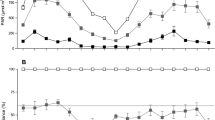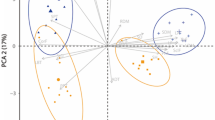Abstract
Bischofia javanica Blume, an exotic tree, dominates many forest areas of the Bonin Islands in the western Pacific of Japan. The aim of this study was to test the hypothesis that the success of B. javanica (a mid-successional plant species) is related to its high acclimation capacity to sudden light increase due to canopy gap formation. We compared its ecophysiological response to simulated canopy opening with those of native species of different successional status: Trema orientalis Blume, Schima mertensiana (Sieb, et Zucc.) Koidz, Elaeocarpus photiniaefolius Hook.Et Arn. and Ardisia sieboldii Miquel. In all species, transfer of leaves developed in shade (5.3% of full sun) to full sun resulted in a substantial initial reduction in the dark-adapted quantum yield of photosystem II (Fv/Fm). T. orientalis, a pioneer plant species, showed the least reduction (38%), whereas E. photiniaefolius and A. sieboldii, both late-successional plant species, demonstrated large reductions (about 80%). In all four native species, Fv/Fm in shade leaves gradually recovered following transfer, but B. javanica recovered more fully and rapidly than the other species. Unlike Fv/Fm, the chlorophyll content in all species did not recover following the initial decline. This indicates that the recovery of quantum yield (Fv/Fm) was independent of the reduction in chlorophyll. Among all the species, B. javanica showed the highest (1) increase in maximum photosynthetic rate of shade leaves after transfer, (2) production of newly formed sun leaves, and (3) increase in relative growth rate. Ecophysiological characters of B. javanica in simulated canopy openings indicated rapid photosynthetic acclimation in existing shade leaves by minimizing photoinhibition and a rapid deployment of new sun leaves with high photosynthetic capacity. Because its habitats on these Pacific Islands are prone to typhoon disturbance, the successful invasion of B. javanica may lie in the congruence of its acclimation potential and the frequent gap events.
Similar content being viewed by others
Author information
Authors and Affiliations
Additional information
Electronic Publication
Rights and permissions
About this article
Cite this article
Yamashita, N., Ishida, A., Kushima, H. et al. Acclimation to sudden increase in light favoring an invasive over native trees in subtropical islands, Japan. Oecologia 125, 412–419 (2000). https://doi.org/10.1007/s004420000475
Received:
Accepted:
Published:
Issue Date:
DOI: https://doi.org/10.1007/s004420000475




